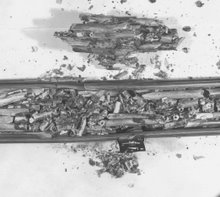Time flies. Here is my work in which I led staff at UCLA about four years ago.
http://boiling.seas.ucla.edu/Publications/Conf_LMWD2003
These days I am reactivating this project in my garage in Sun Valley.
I found this spin-off on the NSF web yesterday, Novenber 21, 2007! WOW!!! $324,981
Award Abstract #0553571 HEAT TRANSFER IN FLUIDS AT NEAR-CRITICAL PRESSURES: EXPERIMENTS AND MATHEMATICAL MODELING
NSF Org:
CBETDivision of Chemical, Bioengineering, Environmental, and Transport Systems
Initial Amendment Date:
September 11, 2006
Latest Amendment Date:
February 28, 2007
Award Number:
0553571
Award Instrument:
Standard Grant
Program Manager:
Patrick E. Phelan CBET Division of Chemical, Bioengineering, Environmental, and Transport SystemsENG Directorate for Engineering
Start Date:
September 15, 2006
Expires:
August 31, 2009 (Estimated)
Awarded Amount to Date:
$324981
Investigator(s):
Gopinath Warrier gwarrier@ucla.edu(Principal Investigator) Vijay Dhir (Co-Principal Investigator)
Sponsor:
University of California-Los Angeles 11000 Kinross Avenue LOS ANGELES, CA 90095 310/794-0102
NSF Program(s):
THERMAL TRANSPORT & THERM PROC
Field Application(s):
0308000 Industrial Technology
Program Reference Code(s):
SMET,OTHR,9251,9178,064E,0000
Program Element Code(s):
1406
ABSTRACTABSTRACT National Science Foundation Proposal Number CTS-0553571
Principal Investigator Warrier, Gopinath Affiliation University of California-Los Angeles
Proposal Title Heat Transfer in Fluids at Near Critical Pressures: Experiments and Mathematical Modeling
High pressure fluids are increasingly being promoted as heat transfer media in a number of thermal and chemical processes such as cryogenic cooling systems, thermosyphons, and large Supercritical Water-Cooled Reactors (SCWR). However, due to the rapid change in fluid properties close to the critical point, the experimental results have yielded both heat transfer enhancement and deterioration. The results for these contradictory results are not clearly understood. In this fundamental study, the heat transfer mechanisms involved during natural convection and boiling from microscale heater elements at near-critical pressures will be investigated. Both Schlieren photography and Particle Image Velocimetry will be employed. Models/correlations suitable for design purposes will be developed based on the experimental data. In addition to the experiments, numerical simulations using Direct Numerical Simulation (DNS) will also be performed. The temperature and velocity data obtained in the experiments will be used to validate the numerical simulations.
Intellectual Merit: The proposed study will greatly advance the basic understanding of heat transfer in fluids at pressures near the critical pressure. The knowledge gained will provide researchers, in academia and industry, with a better understanding of the process. Potential innovative applications of this knowledge include miniature thermosyphons and heat pipes, cryogenic cooling systems, and in a broader sense SCWR thermal-hydraulics during shut down modes and reactor transients.
Broader Impact: The project will support at least two undergraduate students from underrepresented groups to come and work in the laboratory during each summer. This will give the students a chance to gain valuable hands on experience and stimulate their interest in the field of thermal science and engineering. Two Ph.D. students will also be supported as part of this project. The research accomplished will be presented at conferences and published in archival journals for general dissemination by the technical community.
Monday, October 29, 2007
Subscribe to:
Post Comments (Atom)

No comments:
Post a Comment